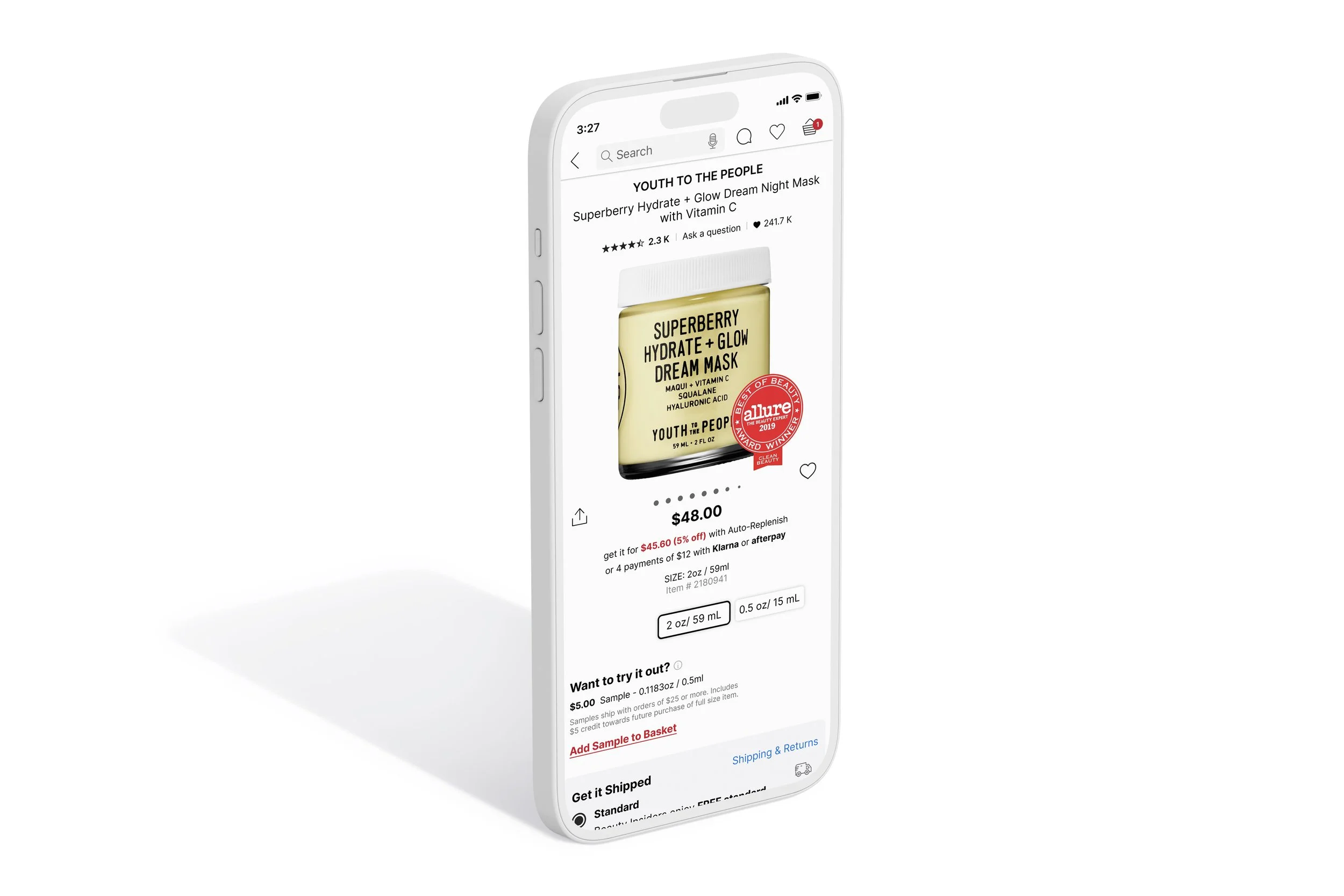Sephora Feature Addition
Adding a sample feature to Sephora’s mobile app
Mobile App
Project Timeline
80 hours, 4 weeks
User research, competitor analysis, concept ideation, product and user goals, user flows, prototyping, user testing, ideation prioritization.
My Role
Finding ways to increase sales and minimize returns for Sephora.com while saving customers money, reducing waste, and ensuring (and growing) overall customer satisfaction.
The Problem
By offering a more universal sample program, users can purchase thoughtfully sized samples of any product at Sephora, and receive a credit towards a future purchase of the full sized item.
The Solution
During my initial competitor analysis, I discovered that many of Sephora’s direct competitors do not offer a feature to purchase samples. Sephora would be among the first to pioneer this idea, giving them a unique advantage to test and perfect the feature. Some beauty brands, like Kosas.com, offer purchasable sample options on their website directly, but I did not find this on any other third-party beauty marketplace platform.
Competitive Analysis
User Interviews / Qualitative Analysis
Understand a user's motivation for trying new products
Understand if there is a real need for a sample option
Discover if people would pay for a sample, and if so how much before they consider just buying the full size product
Learn if there are downsides to why users might not want to purchase samples
Research Objectives:
Users ranging in ages from 25-45
Users who primarily shop at Sephora over other makeup and beauty retailers
Users who typically acquire a high volume of makeup and skincare products and love to experiment
Talked to:
With the feedback and insights I gathered from conducting these interviews, I was able to better understand why and how people shop for products on Sephora.com and other competitor sites. In addition to hearing people’s stories and learning more about their shopping habits, I gained valuable insights on how I might frame the new feature and structure my design later on. I decided to create User Stories to support my research findings and initial hypotheses.
Research Findings
As a user, I want to explore different products in a low-risk way so that I can figure out what works best for me and my skin.
As a user, I want a way to better inform my purchases by reducing waste and not wasting money
User Stories:
Project Goals
Information Architecture & Wireframing
Once I determined the business goals, I began exploring how the information would fit within the existing Sephora website framework. I outlined the following user flow and compared it to Sephora’s existing information architecture to make sure the added feature made sense to users and felt intuitive.
User Flow - Add Sample to Basket
At the mid/low-fidelity stage, I sketched a few different ways user’s could shop for samples to understand what would best support my user flow, ensuring my high fidelity designs would be ready to test with users.
User Testing & Analyzing Results
After A/B testing two high fidelity prototypes with potential users, I analyzed the results using a prioritization matrix to ensure that any final changes I made to the design resulted in the best possible user experience.
An overwhelming majority of users chose option A as their preferred shopping experience
User Feedback:
Option A
Option B
Even though almost all users chose option A, they expressed that the text hierarchy felt off. The CTA link had a higher visual importance, so the users eye went there first, causing them to have to go back up to read what the CTA was referring to.
User Feedback:
By tweaking size, weight and padding, I was able to better balance out the visual hierarchy while retaining the importance of the CTA
How I Addressed It:
Final High Fidelity Screens
Offering this new feature would benefit both Sephora and it’s customers in many ways. Users avoid, or are hesitant to commit to buying new products when they are unable to try it first out of fear of being wasteful and spending too much money. By restructuring the existing sample program, the customers’ needs are met and increased product sales can easily be tied back to the feature addition through the credit offered to customers when purchasing the samples.
The Outcomes
The Details..








